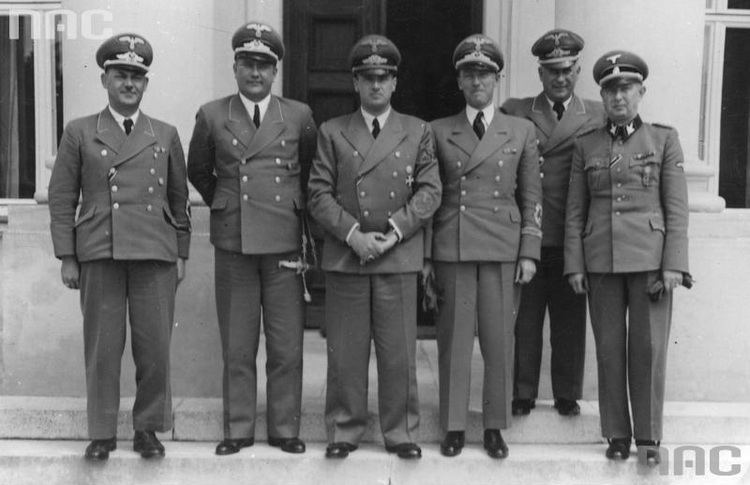 | ||
General Government administration (in German Generalgouvernement für die besetzten polnischen Gebiete) - government and administration of General Government created on part of area of the Second Republic of Poland under Nazi German rule during the duration of World War II between 1939 and early 1945.
Contents
Background
"No government protectorate is anticipated for Poland, but a complete German administration. (...) Leadership layer of the population in Poland should be as far as possible, disposed of. The other lower layers of the population will receive no special schools, but are to be oppressed in some form". - The excerpts of the minute of the first conference of Heads of the main police officers and commanders of operational groups led by Heydrich`s deputy, SS-Brigadefuhrer Dr. Werner Best, Berlin 7 September 1939.
After Invasion of Poland the first German administration on occupied Polish areas was set by German military Wehrmacht. Subordinated to them was improvised civilian "Chiefs of Civil Administration" (Chefs der Zivilverwaltung, CdZ) led by Hans Frank. After ending of military actions between October and November 1939 Germans created administered by a General-Governor (German: Generalgouverneur) aided by the Office of the General-Governor (Amt des Generalgouverneurs), changed on December 9, 1940 to the Government of the General Government (Regierung des Generalgouvernements). His chief was General-Governor (Dr. Hans Frank) and the Office (later, the Government) was headed by Chief of the Government (Regierung, title translated also as the State Secretary or Deputy Governor) Josef Bühler. Several other individuals had powers to issue legislative decrees in addition to the General Governor, most notably the Higher SS and Police Leader of General Government (Friedrich Wilhelm Krüger, later Wilhelm Koppe). All members of the first office:
Status
The General Government had no international recognition. The territories it administered were never either in whole or part intended as any future Polish state. According to the Nazi government the Polish state had ceased to exist, in spite of the existence of a Polish government-in-exile. Its character was that of a puppet state. It was not a Polish puppet government, as there were no Polish representatives above the local administration.
Administrative division
General Government was divided on 5 districts:
Organisation of Government
The government seat of the General Government was located in Kraków (German: Krakau) rather than the traditional Polish capital Warsaw for security reasons. The official state language was German, although Polish continued to be used to a large degree as well, especially on the local levels. Several institutions of the old Polish state were retained in some form for ease of administration. The Polish police, with no high-ranking Polish officers (who were arrested or demoted), was renamed the Blue Police and became subordinated to the Ordnungspolizei. The Polish educational system was similarly kept, but most higher institutions were closed. The Polish local administration was kept, subordinated to new German bosses. The Polish fiscal system, including the złoty currency, was kept, but with revenues now going to the German state. A new bank was created, and was issuing new banknotes. The Government of the General Government has 12 departments:
Collaborators
The Germans sought to play Ukrainians and Poles off against each other. Within ethnic Ukrainian areas annexed by Germany, beginning in October 1939, Ukrainian Committees were established with the purpose of representing the Ukrainian community to the German authorities and assisting the approximately 30,000 Ukrainian refugees who fled from Soviet-controlled territories. These committees also undertook cultural and economic activities that had been banned by the previous Polish government. Schools, choirs, reading societies and theaters were opened, and twenty Ukrainian churches that had been closed by the Polish government were reopened. A Ukrainian publishing house was created in Cracow, which despite having to struggle with German censors and paper shortages was able to publish school textbooks, classics of Ukrainian literature, and the works of dissident Ukrainian writers from the Soviet Union. By March 1941 there were 808 Ukrainian educational societies with 46,000 members. Ukrainian organizations within the General Government were able to negotiate the release of 85,000 Ukrainian prisoners of war from the German-Polish conflict (although they were unable to help Soviet POWs of Ukrainian ethnicity).
After the war, the Polish Supreme National Tribunal declared that the government of the General Government was a criminal institution.
